February pruning of trees, shrubs and climbers

The garden is at its most dormant right now, so it’s a good time to catch up on any pruning that was missed or forgotten in autumn. If the weather isn’t favourable, you can leave it for a week or two, but make sure all winter pruning is completed before the sap starts rising in early spring. There’s still time to prune newly planted trees to remove any damaged growth and help balance the shape of the canopy as well as maintain a dominant main leader. Damaged and lop-sided growth can be removed from many established specimens too, but consult a professional tree surgeon before tackling anything substantial and make sure the tree does not have a preservation order on it before you start. Top of the pruning list right now are: acer, ash, aucuba, billardiera, black gum, bougainvillea, buddleja, campsis, celastrus, clematis, clerodendrum, convolvulus, cotoneaster, crab apple, diervilla, dogwood, Dutchman’s pipe, elder, eucalyptus, garrya, hazel, ivy, Japanese honeysuckle, kolomikta vine, ornamental pear, oak, mountain ash, Persian ironwood, plane tree, potato vine, , snowy mespilus, spindle tree, sweet gum, tulip tree, willow, winter jasmine and wintersweet. Read on to find out how it's done.
TREES
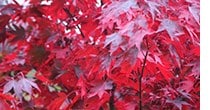 The dormant season is the time to prune acers because they tend to bleed heavily at other times. Any time between November and February is ideal. Specimen trees such as A. davidii, A. negundo, A. saccharinum, A. campestre, A. griseum and Acers grown as multi-stemmed trees on a short trunk, such as A. palmatum, should require very little pruning other than to remove frost-damaged and weak shoots, as well as any badly positioned, crossing or rubbing stems.
The dormant season is the time to prune acers because they tend to bleed heavily at other times. Any time between November and February is ideal. Specimen trees such as A. davidii, A. negundo, A. saccharinum, A. campestre, A. griseum and Acers grown as multi-stemmed trees on a short trunk, such as A. palmatum, should require very little pruning other than to remove frost-damaged and weak shoots, as well as any badly positioned, crossing or rubbing stems.
 Eucalyptus gunnii grown for its ornamental juvenile foliage will need pruning now. Cut back all new growth annually on both coppiced and pollarded specimens. Specimen trees that require pruning to maintain the balance of the canopy can also be tackled now. They also respond well to heavy pruning, so if a tree becomes top-heavy it can be cut back, lopped or topped before growth starts in spring.
Eucalyptus gunnii grown for its ornamental juvenile foliage will need pruning now. Cut back all new growth annually on both coppiced and pollarded specimens. Specimen trees that require pruning to maintain the balance of the canopy can also be tackled now. They also respond well to heavy pruning, so if a tree becomes top-heavy it can be cut back, lopped or topped before growth starts in spring.
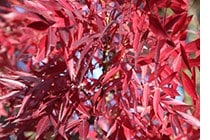 Most ash trees will form an attractive, well-balanced canopy without intervention and so require no pruning other than the removal of crossing or wind-damaged branches. Do this now before new growth starts. Young trees should also be encouraged to produce a clear trunk, so remove lower side branches to gradually raise the canopy as the tree grows. Weeping standards of F. excelsior ‘Pendula’ should only be pruned to remove crossing stems or thinning out congested branches. Take care not to over thin and open up the canopy too much, aiming for evenly spaced branches right around the crown where it joins the main stem.
Most ash trees will form an attractive, well-balanced canopy without intervention and so require no pruning other than the removal of crossing or wind-damaged branches. Do this now before new growth starts. Young trees should also be encouraged to produce a clear trunk, so remove lower side branches to gradually raise the canopy as the tree grows. Weeping standards of F. excelsior ‘Pendula’ should only be pruned to remove crossing stems or thinning out congested branches. Take care not to over thin and open up the canopy too much, aiming for evenly spaced branches right around the crown where it joins the main stem.
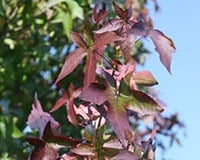 Although regular pruning is unnecessary, it is worth checking that young specimens have formed a single, central leader. If there are competing leaders, this can spoil the overall shape and balance of the tree as it grows. Remove the weakest. Larger trees can benefit from having the lowest branches removed so that the naturally drooping branches are clear of the ground.
Although regular pruning is unnecessary, it is worth checking that young specimens have formed a single, central leader. If there are competing leaders, this can spoil the overall shape and balance of the tree as it grows. Remove the weakest. Larger trees can benefit from having the lowest branches removed so that the naturally drooping branches are clear of the ground.
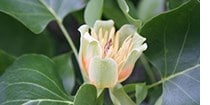 Young trees do not need any routine pruning, other than the removal of crossing or damaged branches. The aesthetic appeal of older trees can enhanced by raising the canopy gradually over a number of years. A clear trunk of 2-3m is ideal on mature specimens. Bear in mind that large wounds are prone to fungal infection, so ensure that each cut is clean and treated with a wound sealant immediately. The weeping form Liriodendron tulipifera ‘Fastigiatum’ should not be pruned to form a clear trunk.
Young trees do not need any routine pruning, other than the removal of crossing or damaged branches. The aesthetic appeal of older trees can enhanced by raising the canopy gradually over a number of years. A clear trunk of 2-3m is ideal on mature specimens. Bear in mind that large wounds are prone to fungal infection, so ensure that each cut is clean and treated with a wound sealant immediately. The weeping form Liriodendron tulipifera ‘Fastigiatum’ should not be pruned to form a clear trunk.
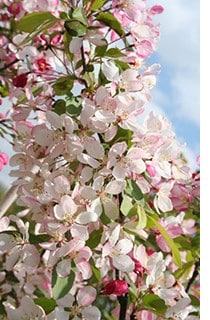 Different species of crab apple naturally produce different shaped canopies and so pruning requirements vary slightly. Some flowering crab apples, such as Malus floribunda, tend to produce a shrub-like, multi-stemmed bush when young, maturing to form a lollipop-shaped canopy of well-spaced branches on a single stem. Prune initially to create a single main stem, and then only to improve the balance and overall shape of the canopy. Remove badly placed or damaged branches, as well as lowest branches to produce a clear stem. Crab apples that naturally produce a dome-shaped canopy of evenly spaced feathered branches, such as the popular ‘Golden Hornet’ and ‘John Downie’, also can be enhanced as they mature by removing the lowest branches to raise the canopy. A few crab apples, such as Malus hupehensis, produce a flame-shaped canopy with a single main leader. These require no pruning as a rule, unless the leader is broken and several lower branches compete to replace it. In this circumstance, select the best positioned and cut back the others by about 15cm to an outward-facing bud. When pruning all crab apples, fast-growing vertical shoots, known as ‘water shoots’ may be produced as a response, and these should be removed completely as soon as they are noticed. Mature crab apple specimens should not be pruned other than the removal or damaged branches, since they are prone to fungal infections.
Different species of crab apple naturally produce different shaped canopies and so pruning requirements vary slightly. Some flowering crab apples, such as Malus floribunda, tend to produce a shrub-like, multi-stemmed bush when young, maturing to form a lollipop-shaped canopy of well-spaced branches on a single stem. Prune initially to create a single main stem, and then only to improve the balance and overall shape of the canopy. Remove badly placed or damaged branches, as well as lowest branches to produce a clear stem. Crab apples that naturally produce a dome-shaped canopy of evenly spaced feathered branches, such as the popular ‘Golden Hornet’ and ‘John Downie’, also can be enhanced as they mature by removing the lowest branches to raise the canopy. A few crab apples, such as Malus hupehensis, produce a flame-shaped canopy with a single main leader. These require no pruning as a rule, unless the leader is broken and several lower branches compete to replace it. In this circumstance, select the best positioned and cut back the others by about 15cm to an outward-facing bud. When pruning all crab apples, fast-growing vertical shoots, known as ‘water shoots’ may be produced as a response, and these should be removed completely as soon as they are noticed. Mature crab apple specimens should not be pruned other than the removal or damaged branches, since they are prone to fungal infections.
Young specimens may need pruning to maintain a balanced canopy and to promote branching. Aim for a feathered framework of up to a half-dozen branches. As the tree matures, remove the lowest branches to form a clear trunk up to about 1m so that the naturally drooping lowest branches that remain do not reach the ground. Also, the appearance of older specimens can be spoilt by vigorous upright shoots produced within the canopy. The should be removed completely while the tree is dormant.
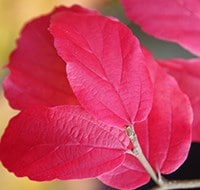 No routine pruning is required. Parrotias can be trained in two ways: shrub-like specimens may need overcrowded shoots thinned to avoid congested growth; while tree-like, standard specimens with a clear stem may need lower branches shortened to reveal the ornamental bark.
No routine pruning is required. Parrotias can be trained in two ways: shrub-like specimens may need overcrowded shoots thinned to avoid congested growth; while tree-like, standard specimens with a clear stem may need lower branches shortened to reveal the ornamental bark.
This popular street tree can be trained as a standard with a single leader and a clear trunk to 3m or as a feathered tree with branches down to near ground level. In either case, little pruning is required other than the removal of crossing or damaged branches. Poorly shaped crowns can be balanced during the dormant season by cutting out misplaced shoots and branches. As the tree matures, remove the lower branches to create a clear stem. Even on feathered trees, aim to remove branches below 1.2m so that the naturally drooping lowest branches that remain do not touch the ground. Established trees tolerate heavy pruning so that the crowns can be reduced or thinned to keep within bounds or to allow more light to filter down to ground level in summer. However, these are major operations and should only be carried out by a trained profession tree surgeon.
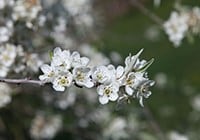
All ornamental pears, including the popular variety ‘Chanticleer’, produce a single-leader standard with a pyramid-shaped canopy. No routine pruning is necessary except to remove baldly positioned or damaged branches that unbalance the overall shape. Aim for evenly spaced side branches all the way around the trunk. Also remove lower branches over several years as the tree matures to create a clear trunk up to 2m. Even the weeping variety ‘Pendula’ needs a clear stem to allow sufficient room for the cascading branches.
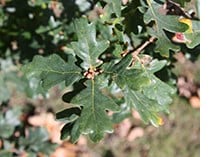 Train young deciduous oaks as a single-leader standard so that they form the classical domed-shaped canopy as they mature. Evergreen oaks, such as Quercus ilex, should be allowed to form a more feathered structure to the canopy so that the leader is only slightly more dominant than the surrounding side shoots. Hedges of Quercus ilex should not be trimmed until April and again in early September. With all oaks, no routine pruning is required other than the removal of crossing or damaged branches. Lateral branches that form low down on the stem should be removed as the tree matures to leave a clear trunk up to 2.5m. More serious renovation of mature specimens should only be carried out by a trained profession tree surgeon.
Train young deciduous oaks as a single-leader standard so that they form the classical domed-shaped canopy as they mature. Evergreen oaks, such as Quercus ilex, should be allowed to form a more feathered structure to the canopy so that the leader is only slightly more dominant than the surrounding side shoots. Hedges of Quercus ilex should not be trimmed until April and again in early September. With all oaks, no routine pruning is required other than the removal of crossing or damaged branches. Lateral branches that form low down on the stem should be removed as the tree matures to leave a clear trunk up to 2.5m. More serious renovation of mature specimens should only be carried out by a trained profession tree surgeon.
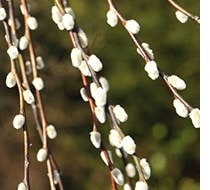
Willows grown as trees should be trained a single-leader standard. Little pruning is required other than the removal of crossing or damaged branches. Weeping willows are best left alone unless you want to raise the canopy of mature specimens to create a clear 2m trunk to achieve a more classical weeping silhouette. Willows grown as shrubs for their ornamental stems need annual pruning (see shrubs, below). Top-grafted weeping forms of willow, such as the popular ‘Kilmarnock’, also should be pruned annually once well established to maintain its overall shape. Thin out branches to create a tracery of evenly spaced stems that form a complete skirt around the tree. Then shorten the branches that remain to an outward-facing bud so that new growth will reach the ground by the end of the coming growing season. Also remove any upright or horizontal growths that soil the cascading shape of the canopy.
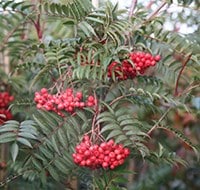 All sorbus should be trained as a single-leader standard. Little pruning is required other than the removal of crossing or damaged branches. Lateral branches that form low down on the stem should be removed as the tree matures to leave a clear trunk up to 2m high. On grafted specimens, suckers that are produced below the graft union should be removed completely as soon as they are noticed.
All sorbus should be trained as a single-leader standard. Little pruning is required other than the removal of crossing or damaged branches. Lateral branches that form low down on the stem should be removed as the tree matures to leave a clear trunk up to 2m high. On grafted specimens, suckers that are produced below the graft union should be removed completely as soon as they are noticed.
This shrubby tree should be trained as a single-leader initially, allowing a feathered crown of branches on a short trunk, so that the leader is only slightly more dominant than the surrounding side shoots. No routine pruning is necessary. However, lower branches will be shaded out as the tree matures and such branches can be removed completely.
SHRUBS
This large multi-stemmed shrub or tree that initially can be pruned to open the center of the crown. Damaged, misplaced and diseased stems should be removed, with the remained thinned out if necessary. As specimens mature they may need renovating by cutting out one-in-three stems, starting with the oldest. After a three-year period, the whole shrub will have been rejuvenated. Amelanchier lamarckii can also be trained as a single stemmed tree. No routine pruning is necessary. However, the lowest branches can be removed as the tree matures to leave a short clear 50cm trunk.
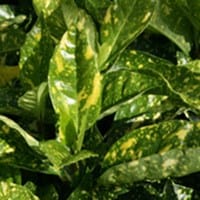
Although fruiting Japanese laurels are best pruned during March or April, non-fruiting male varieties, such as Aucuba japonica ‘Crotonifolia’, can be pruned now. Initially, prune back new growth by about one-third to promote bushy growth. Thereafter, little pruning is required except the removal of upright shoots that spoil its shape and all-green reverted shoots on variegated varieties. Neglected old plants that have become woody at the base can be improved by cutting out one-stem-in-three each year starting with the oldest stems, until the whole plant has been rejuvenated. Apply a generous 5-7cm (2-3in) mulch of well-rotted garden compost or manure around the base of the plant after pruning. Japanese laurel hedges should be trimmed with secateurs rather than shears to keep compact, since this will avoid leaving damaged foliage on the clipped hedge.
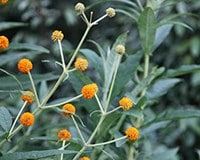
Buddleja globosa flowers on wood produced the previous year, so as a rule should only be pruned directly after flowering in June or July. However, neglected plants that flower out of sight high up on the bush, or have become bare and unsightly at the base, can be rejuvenated by cutting back now. Although, this year’s flowers will be lost from the stems removed, new vigorous growth will be produced that will flower the following year. Very tall stems can be reduced by cutting them back to a side shoot lower down and the whole plant can be rejuvenated by cutting out one-stem-in-three starting with the oldest. You’ll still get 66 percent of the flowers and a completely new plant within three years.
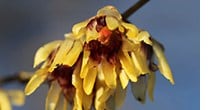 Little or no routine pruning is necessary on specimen shrubs, other than the removal of crossing or damaged branches. Neglected old plants that have become woody at the base can be improved by cutting out one-stem-in-three each year starting with the oldest stems, until the whole plant has been rejuvenated. Wall-trained shrubs can have flowered shoots pruned back as soon as the display fades. Cut back each stem to an outward-facing bud a few buds for its base.
Little or no routine pruning is necessary on specimen shrubs, other than the removal of crossing or damaged branches. Neglected old plants that have become woody at the base can be improved by cutting out one-stem-in-three each year starting with the oldest stems, until the whole plant has been rejuvenated. Wall-trained shrubs can have flowered shoots pruned back as soon as the display fades. Cut back each stem to an outward-facing bud a few buds for its base.
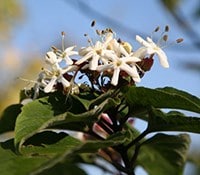 A thicket-forming shrub that should be pruned in the early years before the buds break in spring. Plants with a single main stem should be cut back to a healthy bud about 60cm above the ground. The following year, select half-a-dozen well-spaced sideshoots and remove the rest to create the basic structure of the shrub. Thereafter, no routine pruning is necessary other than the removal of crossing or damaged branches. Take care not to cultivate the soil around established shrubs, since this can lead to suckers being thrown up by damaged roots. If suckers are a problem, they can be removed by excavating the soil to reveal where the sucker joins the parent plant. Then pull sharply on the sucker to tear it away from the parent plant. Do not cut off suckers since this will encourage further, more vigorous, suckers to be produced.
A thicket-forming shrub that should be pruned in the early years before the buds break in spring. Plants with a single main stem should be cut back to a healthy bud about 60cm above the ground. The following year, select half-a-dozen well-spaced sideshoots and remove the rest to create the basic structure of the shrub. Thereafter, no routine pruning is necessary other than the removal of crossing or damaged branches. Take care not to cultivate the soil around established shrubs, since this can lead to suckers being thrown up by damaged roots. If suckers are a problem, they can be removed by excavating the soil to reveal where the sucker joins the parent plant. Then pull sharply on the sucker to tear it away from the parent plant. Do not cut off suckers since this will encourage further, more vigorous, suckers to be produced.
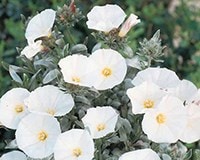 A mound-forming evergreen shrub that needs no routine pruning other than the removal of uncharacteristic shoots that disfigure its overall shape and appearance. These are best removed completely or cut back to a side shoot lower down, before buds break in early spring.
A mound-forming evergreen shrub that needs no routine pruning other than the removal of uncharacteristic shoots that disfigure its overall shape and appearance. These are best removed completely or cut back to a side shoot lower down, before buds break in early spring.
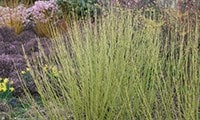 Dogwoods grown for their attractive winter stems, such as the coral-red C. alba ‘Sibirica’, brilliant red C. alba ‘Elegantissima’, orange-red C. sanguinea ‘Midwinter Fire’ and lime-green C. sericea ‘Flaviramea’, can be pruned during early spring before the buds break to promote new, young and vibrant stems each year. There are various complicated ways of pruning cornus, but if you cut back the whole bush to between 15-30cm from ground level, you will get a wonderful new display each year. If you find this too drastic, cut out just one stem in three starting with the oldest.
Dogwoods grown for their attractive winter stems, such as the coral-red C. alba ‘Sibirica’, brilliant red C. alba ‘Elegantissima’, orange-red C. sanguinea ‘Midwinter Fire’ and lime-green C. sericea ‘Flaviramea’, can be pruned during early spring before the buds break to promote new, young and vibrant stems each year. There are various complicated ways of pruning cornus, but if you cut back the whole bush to between 15-30cm from ground level, you will get a wonderful new display each year. If you find this too drastic, cut out just one stem in three starting with the oldest.
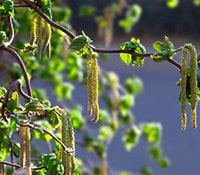 There’s still time to prune thicket-forming hazels to encourage vigorous new growth. Simply cut out one-stem-in-three each year starting with the oldest stems, until the whole plant has been rejuvenated. Hazels respond particularly well to drastic pruning, so neglected old plants that have become woody at the base can be improved by cutting all stems back in the same year. However, the ornamental corkscrew hazel ‘Contorta’ is best pruned lightly to keep within bounds or reduce congestion. As the tree matures the twists in the stem can cause the bark to split and whole branches to crack. If such damage is seen it should be pruned out while the shrub is dormant. Well-established corkscrew hazels that need complete renovation, can have one-stem-in-three cut out each year starting with the oldest stems.
There’s still time to prune thicket-forming hazels to encourage vigorous new growth. Simply cut out one-stem-in-three each year starting with the oldest stems, until the whole plant has been rejuvenated. Hazels respond particularly well to drastic pruning, so neglected old plants that have become woody at the base can be improved by cutting all stems back in the same year. However, the ornamental corkscrew hazel ‘Contorta’ is best pruned lightly to keep within bounds or reduce congestion. As the tree matures the twists in the stem can cause the bark to split and whole branches to crack. If such damage is seen it should be pruned out while the shrub is dormant. Well-established corkscrew hazels that need complete renovation, can have one-stem-in-three cut out each year starting with the oldest stems.

Prostrate cotoneasters, such as C. horizontalis, C. dammeri and C. microphyllus, can be pruned now to remove any shoots that disfigure their overall appearance. Spreading branches can also be thinned or cut back to keep these shrubs within their allotted growing areas. Cotoneaster horizontalis trained against a wall or fence should have stems that are growing away from the support removed, so that it fans out neatly.
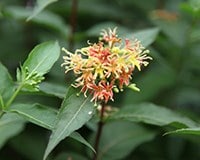 A thicket-forming shrub that responds well to annual pruning which promotes vigorous new growth with attractive bronze foliage. If you cut back the whole bush to 30cm from ground level, you will get a wonderful new display each year. Neglected old plants also respond well to severe pruning at this time of the year.
A thicket-forming shrub that responds well to annual pruning which promotes vigorous new growth with attractive bronze foliage. If you cut back the whole bush to 30cm from ground level, you will get a wonderful new display each year. Neglected old plants also respond well to severe pruning at this time of the year.
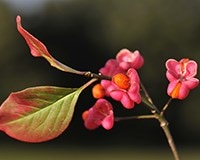 Thin congested growth on well-established specimens of E. europaeus and E. alatus by cutting back misplaced stems to near ground level. You can also shorten over-long shoots to keep the shrub within bounds and well-balanced. Neglected specimens can be improved by cutting out one-stem-in-three each year starting with the oldest stems, until the whole shrub has been rejuvenated.
Thin congested growth on well-established specimens of E. europaeus and E. alatus by cutting back misplaced stems to near ground level. You can also shorten over-long shoots to keep the shrub within bounds and well-balanced. Neglected specimens can be improved by cutting out one-stem-in-three each year starting with the oldest stems, until the whole shrub has been rejuvenated.
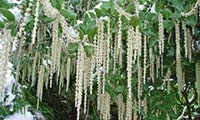 Free-standing shrubs require no routine pruning, other than the removal of crossing or damaged branches. Wall-trained specimens should have misplaced shoots removed and stems reduced in length so that the shrub can be kept within bounds. Neglected shrubs can be improved by cutting back growth to a central framework of branches. This should not all be done in a single year, but staggered over four or five years, until the whole plant has been rejuvenated. Any pruning is best done after flowering in early spring.
Free-standing shrubs require no routine pruning, other than the removal of crossing or damaged branches. Wall-trained specimens should have misplaced shoots removed and stems reduced in length so that the shrub can be kept within bounds. Neglected shrubs can be improved by cutting back growth to a central framework of branches. This should not all be done in a single year, but staggered over four or five years, until the whole plant has been rejuvenated. Any pruning is best done after flowering in early spring.
For the best ornamental brambles, prune each year during early spring. Flowering brambles such as R. odoratus, R. spectabilis and the popular variety ‘Beneden’ should have one-stem-in-three cut out each year, starting with the oldest stems that flowered during the previous year. To get the best displays from white-stemmed brambles, such as R. biflorus, R. cockburnianus and R. thibetanus, cut all the stems back to ground level.
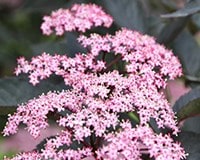
Slow-growing ornamental varieties of elder require no routine pruning. Varieties of elder that are grown for their dramatic cut-leaf displays, such as the burnished gold ‘Sutherland Gold’ or the near black ‘Black Lace’ and ‘Black Beauty’, should be pruned annually during early spring so that they produce vigorous new growth and the most flamboyant foliage displays. Cut back all new growth to an established stubby framework of branches 15-45cm from the ground. To get taller plants, at the back of the border, say, make the framework 1m or so high. Other elders can also be pruned now to keep neat and tidy. To get flowers and berries cut out one-stem-in-three each year starting with the oldest.
Little routine pruning is required other than the removal of faded flower-heads along with any straggly shoots in autumn. As the shrub ages it may become open exposing ugly woody growth. In this situation, cut back the flowered shoots to within 2.5cm (1in) of the old growth now.
CLIMBERS
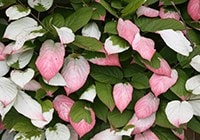 Before new growth starts in early spring, kolomikta vines can be pruned to keep them within bounds. First, remove any crossing, diseased or over-crowded stems. Established plants should then have the previous year’s growth cut back by about half its length, cutting back to an outward-facing bud. Neglected plants also can be rejuvenated by cutting back the mass of tangled growth with shears, then pruning the stems back to a healthy bud near to the main framework of branches. Kolomikta vines even respond to drastic pruning – thinning or lopping out some of the main framework of branches at this time of the year to a younger sideshoot lower down on the climber.
Before new growth starts in early spring, kolomikta vines can be pruned to keep them within bounds. First, remove any crossing, diseased or over-crowded stems. Established plants should then have the previous year’s growth cut back by about half its length, cutting back to an outward-facing bud. Neglected plants also can be rejuvenated by cutting back the mass of tangled growth with shears, then pruning the stems back to a healthy bud near to the main framework of branches. Kolomikta vines even respond to drastic pruning – thinning or lopping out some of the main framework of branches at this time of the year to a younger sideshoot lower down on the climber.
No routine pruning is required, other than the removal of crossing or damaged stems. This is best carried out just before buds break in spring. To restrict the size of established plants, cut back new growth to within a few buds of the main framework. Dutchman’s pipe also responds well to more drastic pruning so neglected specimens can be cut back hard at this time of the year by pruning the main framework to a younger sideshoot produced lower down each main stem.
No routine pruning is required, other than the removal of crossing or damaged stems. Overgrown plants can be thinned by cutting back unwanted shoots to within a few buds of the main framework.
To get the best displays, you need to train a framework of well-spaced branches up the support. During early spring, just before new growth starts, cut back last-year’s growth by about two-thirds – pruning to a plump outward-facing bud. Remove any weak or misplaced stems completely. Once the climber has covered its support, cut back all new growth to just two or three buds from the established framework. Older plants can be invigorated by removing two or three of the oldest framework stems, cutting back to a younger sideshoot near the base. All other side shoots that appear on the main framework should be pruned back to two or three buds.
Prune Chinese trumpet vine in early spring before new growth starts, to promote flowering stems and to keep within bounds. Aim to create a framework of well-spaced branches over the supporting trellis or wires. Once the framework is established, cut back the previous season’s growth to just two or three buds from the established framework. Remove any weak or misplaced stems completely. Older plants can be invigorated by removing two or three of the oldest framework stems, cutting back to a younger sideshoot near the base. Campsis responds well to severe pruning, so neglected plants can be restored by cutting the whole framework back to 30cm of the ground.
No routine pruning is required other than the removal of crossing or damaged stems. Indeed, severe pruning will stimulate vigorous leafy growth at the expense of flowering shoots. However, new shoots and sideshoots that have grown beyond the support can be cut back to two or three buds from their base. Neglected plants can be cut back hard to 30cm of the ground, but flowering will be reduced for a few seasons.
 Clematis can be divided into three groups according to their pruning requirements.
New plants are pruned the same in the first year after planting. During early spring, cut back all stems to a plump pair of buds about 30cm above ground level. This will encourage more shoots to be produced from the base for the next year. You may miss some flowering in the first two years, but a much stronger plant will result.
Clematis can be divided into three groups according to their pruning requirements.
New plants are pruned the same in the first year after planting. During early spring, cut back all stems to a plump pair of buds about 30cm above ground level. This will encourage more shoots to be produced from the base for the next year. You may miss some flowering in the first two years, but a much stronger plant will result.
Group 1 clematis, which include all the winter and spring-flowering clematis such as C. alpina, C. armandii, C. cirrhosa, C. macropetala and C. montana varieties, bare their flowers on growth produced the previous season, so need little or no pruning once established.
Group 2 clematis, which include most large-flowered varieties, bloom during early summer on the growth made the previous season as well as a smaller flush during late summer on the new growth made during the current year. In the second year after planting, cut back all stems to 1m during early spring. In subsequent years, prune by cutting back all stems to a pair of healthy buds. However, you can achieve a near-continuous display of flowers throughout the summer months by cutting back half the shoots only.
Group 3 clematis, which include the the C. viticella and ‘Jackmanii’ varieties, flower during late summer on growth produced during the current season only. In the second year after planting and in subsequent years, prune during early spring. Cut back all stems to just above the base of the previous year’s growth, about 30 - 75cm above soil level. Pruning to the lowest pair of healthy buds.
With all clematis, apply a slow-release balanced fertiliser and a mulch of well-rotted garden compost around the plant after pruning, avoiding the immediate crown.
 Prune ivies, during early spring before new growth starts, to keep within bounds and to tidy appearance. Cut back wayward shoots to just above a bud lower down the stem. Remove overcrowded shoots entirely. Keep wall-grown ivies neat by removing shoots growing away from the support. Ivies respond well to severe pruning so old, neglected plants can be reinvigorated by hard pruning - cutting back to 50cm of the base.
Prune ivies, during early spring before new growth starts, to keep within bounds and to tidy appearance. Cut back wayward shoots to just above a bud lower down the stem. Remove overcrowded shoots entirely. Keep wall-grown ivies neat by removing shoots growing away from the support. Ivies respond well to severe pruning so old, neglected plants can be reinvigorated by hard pruning - cutting back to 50cm of the base.
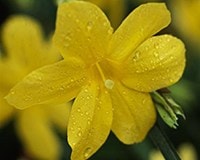 Winter jasmine should be pruned after flowering during early spring. Aim to create a framework of well-spaced branches over the support. Once well-established, cut back shoots not needed to extend the framework to two or three buds of their base. Winter jasmine tolerates hard pruning so neglected plants can be reinvigorated by cutting back to 50cm of the base.
Winter jasmine should be pruned after flowering during early spring. Aim to create a framework of well-spaced branches over the support. Once well-established, cut back shoots not needed to extend the framework to two or three buds of their base. Winter jasmine tolerates hard pruning so neglected plants can be reinvigorated by cutting back to 50cm of the base.
 Once the honeysuckle has reached the top of its support, tip-back the shoots to encourage flowering sideshoots to develop. Well-established plants can become over-congested if left unpruned, so thin out the main stems every few years by cutting back to a newer sideshoot lower down. Neglected plants can become a top-heavy mass of twining stems if not pruned regularly - with flowers out of sight on the top. Give it a short-back-and-sides, then reducing the number of main stems removing any awkwardly placed or crossing stems first. If you want a complete clearout, honeysuckles do respond well to hard pruning in winter to within 30cm of the ground, but you will have a big gap and reduced display for a few years.
Once the honeysuckle has reached the top of its support, tip-back the shoots to encourage flowering sideshoots to develop. Well-established plants can become over-congested if left unpruned, so thin out the main stems every few years by cutting back to a newer sideshoot lower down. Neglected plants can become a top-heavy mass of twining stems if not pruned regularly - with flowers out of sight on the top. Give it a short-back-and-sides, then reducing the number of main stems removing any awkwardly placed or crossing stems first. If you want a complete clearout, honeysuckles do respond well to hard pruning in winter to within 30cm of the ground, but you will have a big gap and reduced display for a few years.
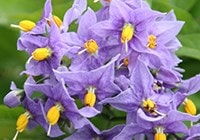 Established plants should be pruned each year during early spring to thin out overcrowded growth and restrict the size of the climber. Aim to create a framework of well-spaced branches over the support. Once well-established, cut back shoots not needed to extend the framework to two or three buds of their base. Neglected plants can be tricky to rejuvenate because they do not respond to severe pruning. Instead, cut out one-stem-in-three from the framework, starting with the oldest, every other year. Ideally cut back to a newer sideshoot lower down, or cut right back to the base if no suitable shoots exist.
Established plants should be pruned each year during early spring to thin out overcrowded growth and restrict the size of the climber. Aim to create a framework of well-spaced branches over the support. Once well-established, cut back shoots not needed to extend the framework to two or three buds of their base. Neglected plants can be tricky to rejuvenate because they do not respond to severe pruning. Instead, cut out one-stem-in-three from the framework, starting with the oldest, every other year. Ideally cut back to a newer sideshoot lower down, or cut right back to the base if no suitable shoots exist.

































